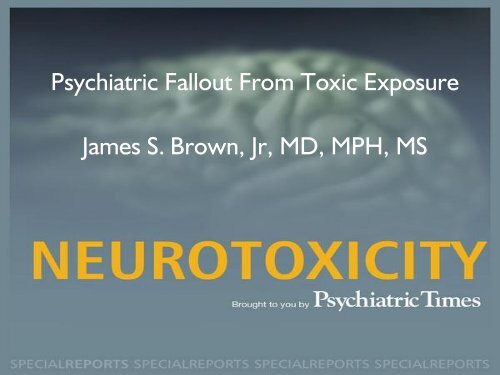Psychiatric Fallout From Toxic Exposure James S Brown Jr MD MPH MS
PT_102016_NeuroToxSR
PT_102016_NeuroToxSR
You also want an ePaper? Increase the reach of your titles
YUMPU automatically turns print PDFs into web optimized ePapers that Google loves.
<strong>Psychiatric</strong> <strong>Fallout</strong> <strong>From</strong> <strong>Toxic</strong> <strong>Exposure</strong><br />
<strong>James</strong> S. <strong>Brown</strong>, <strong>Jr</strong>, <strong>MD</strong>, <strong>MPH</strong>, <strong>MS</strong>
An Update on <strong>Psychiatric</strong> Effects of <strong>Toxic</strong> <strong>Exposure</strong>s<br />
<strong>Psychiatric</strong> effects of environmental and chemical toxins were described in the<br />
medical literature as early as 1850. In the 21st century there has been, sadly, no<br />
shortage of victims of environmental disasters to assess and treat according to<br />
guidelines presented in this Special Report on environmental and chemical<br />
toxins, with an introduction by Chair <strong>James</strong> S. <strong>Brown</strong>, <strong>Jr</strong>, <strong>MD</strong>, <strong>MPH</strong>, <strong>MS</strong>.
Neurobiology and Clinical Manifestations of Methamphetamine Neurotoxicity<br />
The short- and long-term behavioral and physiological effects of methamphetamine<br />
neurotoxicity are devastating. Illicit drugs such as “ecstasy” are often adulterated<br />
with methamphetamine. Solvent abuse that results in altered mental status and<br />
potentially lethal physical abnormalities remains a frequent presentation in the<br />
emergency setting. Occupational exposure to various solvents also results in<br />
neuropsychiatric injury, often referred to as “chronic solvent encephalopathy.”<br />
Contaminants including thallium or infectious agents such as anthrax can be<br />
consumed with illicit drugs. Methamphetamines are also considered an “emerging<br />
contaminant” of water, a term that describes the growing numbers of toxins that<br />
enter the human environment—especially surface water. For a mobile-friendly<br />
view of the Figure, click here.
Synergistic neurotoxicity of methamphetamine<br />
A significant percentage of methamphetamine users are HIV-positive and are<br />
being treated with antiretroviral agents, which may increase methamphetamine<br />
concentration in the plasma. Betulinic acid and its derivatives might potentiate<br />
neurotoxicity in high-dose methamphetamine users. The Figure represents<br />
synergistic neurotoxicity of methamphetamine (METH) and betulinic acid (BA)<br />
to monoaminergic terminals in the rat striatum of male late adolescent rats. For<br />
a mobile-friendly view of the Figure, click here.
Significance for the practicing psychiatrist<br />
Understanding the relationship between the molecular mechanisms<br />
underlying the neurotoxicity of methamphetamine and related clinical<br />
manifestations is imperative to provide more effective treatments. This<br />
article highlights neurobiology of methamphetamine toxicity, clinical<br />
manifestations of methamphetamine neurotoxicity, and implications for<br />
treatment of chronic methamphetamine users. For a mobile-friendly view of<br />
the Monarch notes, click here.
On the Mark: Translating Biomarker Technology to Clinical Neurotoxicity<br />
Chemicals that receive the most attention are those we are routinely exposed<br />
to in our daily lives. The sources of these exposures are as varied as the<br />
chemicals themselves: pesticides on produce, flame-retardant compounds on<br />
furniture, metals in drinking water, and various chemicals used to manufacture<br />
consumer products that have simplified our lives. Research on the impact of<br />
these chemicals has highlighted several neurological targets that are disturbed.<br />
These findings are further supported through population-based studies that<br />
have established some chemicals as significant risk factors for neurological<br />
deficits.
Significance for the practicing psychiatrist<br />
The etiopathogenesis of neuropsychiatric disorders is complex. The<br />
application and integration of a multidimensional biomarker assessment can<br />
significantly improve diagnostic accuracy and assist in formulating a suitable<br />
therapeutic intervention strategy. <strong>Exposure</strong> to neurotoxic chemicals is a<br />
significant contributor to a variety of neuropsychiatric. disorders. Such<br />
exposures and the subsequent pathogenesis that arises must be delineated<br />
from other exogenous or endogenous etiologies to effectively diagnose and<br />
treat the disorder. Application of a systems toxicology approach can leverage<br />
biomarkers of neurotoxicity and facilitate these processes. For a mobilefriendly<br />
view of the Monarch notes, click here.
The Influence of Diet on ADHD<br />
Emerging evidence reveals that aspects of diet can indeed affect ADHD. For<br />
example, research has consistently shown that restriction/elimination diets may<br />
be effective in reducing ADHD symptoms. In addition, for some youths, a diet<br />
free of processed foods containing additives, particularly colorings and<br />
preservatives, may improve symptoms. Further, the best established evidence<br />
to date indicates that the severity of ADHD symptoms may be reduced by a<br />
combination of supplementation with omega-3 fatty acids combined with<br />
reducing or removing processed foods, especially those high in food colors and<br />
preservatives.
Environmental <strong>Toxic</strong>ants and Autism Spectrum Disorder<br />
A growing body of scientific literature associates symptoms of autism<br />
spectrum disorder (ASD) with environmental toxin exposure, including<br />
exposures from contaminants in herbal remedies, heavy metals (especially<br />
during fetal growth), polychlorinated biphenyls, bisphenol A, and<br />
organophosphate pesticides. The case vignette in this article describes ASD<br />
symptoms from the use of Ayurvedic herbs, which emphasizes the<br />
importance of asking patients about herbal use.
Understanding the Link Between Lead <strong>Toxic</strong>ity and ADHD<br />
A report on the current status of lead as a contributor to pediatric<br />
psychiatric problems with recommendations on how to counsel families<br />
anxious about lead exposure. The author points out that levels above 5<br />
µg/dL require clinical interventions and that levels lower than 1 µg/dL have<br />
been associated with behavioral problems. The importance of this finding is<br />
reflected by the recent Flint, Michigan, drinking water crisis in which 99,000<br />
residents were potentially exposed to lead-contaminated water between<br />
2014 and 2015.
Significance for the practicing psychiatrist<br />
When ADHD is present, a survey of possible lead exposure should be<br />
considered. Lead’s association with ADHD is well-established even at the<br />
historically reduced levels currently typical in the US population. Recent<br />
evidence supports a causal, not merely correlational, association even at<br />
supposedly safe levels of lead exposure. Clinicians can offer many practical steps<br />
to parents to mitigate potential harmful effects and risks of low-level lead<br />
exposure on brain development. For a mobile-friendly view of the Monarch<br />
notes, click here


